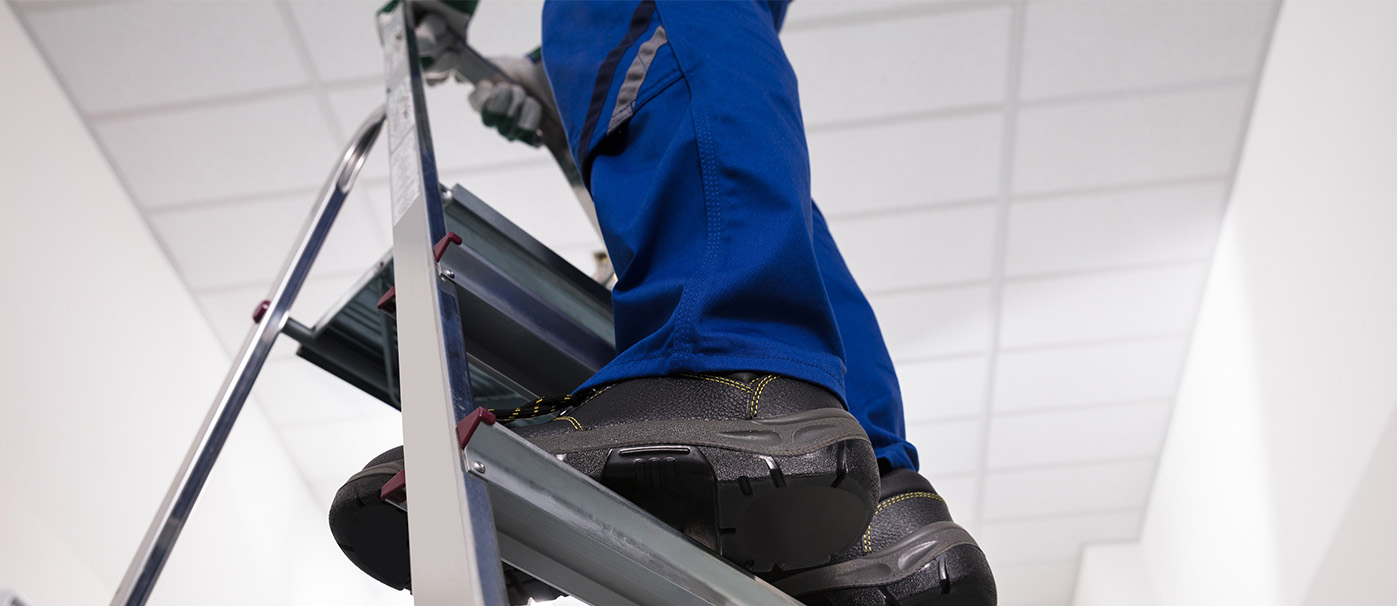The 101 Guide To Using A Ladder Safely And Correctly
Most of us use ladders at some point. But are you taking a risk with every step? Here are Steve Chadwick of Master Electricians Australia’s tips to ensure you’re using a ladder with minimum chance of injury.
Even if it looks pretty straightforward, you should only use a ladder if you have been trained in how to inspect, set up and use ladders correctly. Here are a few basics.
Choosing a ladder
A ladder should be selected to suit the work to be carried out. Consider hazards present, duration of the work, the physical surroundings of where the work is to be carried out and the prevailing weather conditions.
Depending on the specific task and how it is carried out, step platforms should provide an improved level of fall protection over traditional step or single ladders, as they include a small working platform and a partial handrail.
Ladders must have a load rating of at least 120kg and be manufactured for industrial use. Domestic or homemade ladders should not be used on industrial or construction sites.
Ladder maintenance
Ladders should be regularly inspected by a competent person in accordance with the manufacturer’s recommendations. Ladders with any of the following faults should be immediately removed from service and either replaced or repaired:
• Fibreglass stiles cracked, chipped, or severely faded with fibres exposed.
• Timber stiles warped, splintered, cracked, or bruised.
• Metal stiles twisted, bent, kinked, crushed or with cracked welds.
• Rungs, steps, treads, or top plates that are missing, worn, damaged or loose.
• Tie rods missing, broken or loose.
• Ropes, braces, or brackets that are missing, broken or worn.
• Timber members that are covered with opaque paint or other treatment that could disguise faults in the timber.
• Missing, loose, bent or worn fasteners – that is, rivets, bolts, and pins.
• Worn, damaged or damaged feet including non-slip material.
“Maintain ‘three points of contact’. When going up or down a ladder, always have two feet and one hand — or one foot and two hands — on the ladder.”
Using a ladder safely
Before setting up a ladder, it should be inspected for visible damage or faults – for example, broken rungs, stiles, and footings. Faulty or damaged ladders must be removed from service.
When setting up a ladder, you should check that:
• The ladder is the correct height for the work to avoid over-reaching or stretching.
• Locking devices on the ladder are secure.
• The ladder is not placed so that the weight of the ladder and any person using the ladder is supported by the rungs.
Ladders used at a workplace should be set up on a solid and stable surface, and to prevent the ladder from slipping. Single and extension ladders can be prevented from slipping by:
• Ensuring the ladder has non-slip feet.
• Placing ladders at a slope of 4:1 (the distance between the ladder base and the supporting structure should be about 1 metre for every 4 metres of working ladder height).
• Securing ladders at the top or bottom, or if necessary, at both ends.
Stepladders should be set up in the fully opened position and may require a second person to ‘foot’ the ladder for added stability.
Climbing a ladder
Always maintain ‘three points of contact’. When going up or down a ladder, always have two feet and one hand, or one foot and two hands, on the ladder. When working from a ladder, have two feet and one other point of contact with the ladder, such as a hand or thighs leaning against the ladder.
• Use a tool belt or side pouch so that materials or tools are not carried in the hands while climbing the ladder.
• Ensure only light duty work is carried out while on the ladder, where tools can be operated safely with one hand.
• Make sure that no-one works underneath the ladder.
• Do not allow anyone else on the ladder at the same time.
• Do not straddle the ladder.
• Wear slip-resistant footwear.
• Never overreach from the ladder—the centre of the torso should be within the ladder stiles throughout the work.
Ladder don’ts
• Don’t use metal or metal reinforced ladders when working on live electrical installations.
• Don’t carry out ‘hot’ work like arc welding or oxy cutting.
Except where additional fall protection equipment is used in conjunction with the ladder, you should never:
• Use a stepladder near the edge of an open floor, penetration or beside a railing.
• Use power or hand tools requiring two hands to operate, for example concrete cutting saws and circular saws.
• Use tools that require a high degree of leverage force which, if released, may cause the user to over-balance or fall from the ladder, for example drills or pinch bars.
• Face away from the ladder when going up or down, or when working from it.
• Stand on a rung closer than 900 mm to the top of a single or extension ladder.
• Stand higher than the second tread below the top plate of a stepladder with the exception of three-rung stepladders, unless working through an overhead opening of the building or structure that provides appropriate additional support above the ladder.
When you need additional safety precautions
Ladder use in the following situations should only be carried out with additional safety precautions in place:
• In access areas or doorways—if necessary, erect a barrier or lock the door shut.
• Next to powerlines unless the worker is trained and authorised and the correct ladder for the work is being used.
• In very wet or windy conditions.
• Next to traffic areas unless the working area is barricaded.
Using a ladder for exit or entry on a worksite
Where single or extension ladders are used for entry and exit, you should check that:
• There is a firm, stable work platform, free from obstructions, to step onto from the ladder.
• The ladder is securely fixed.
• The ladder extends at least one metre above the stepping-off point on the working platform.
• Fall protection is provided at the stepping-off point where people access the working platform.





Comments (0)
Write a Comment